| Minotaur | |
|---|---|
_at_the_National_Archaeological_Museum_of_Athens_on_3_April_2018.jpg.webp) Minotaur bust (National Archaeological Museum of Athens) | |
| Other names | Asterion |
| Abode | Labyrinth, Crete |
| Personal information | |
| Parents | Cretan Bull and Pasiphaë |
| Siblings | Acacallis, Ariadne, Androgeus, Glaucus, Deucalion, Phaedra, Xenodice and Catreus |
In Greek mythology, the Minotaur (/ˈmaɪnətɔːr, ˈmɪnətɔːr/ MY-nə-tor, MIN-ə-tor,[1] US: /ˈmɪnətɑːr, -oʊ-/ MIN-ə-tar, -oh-;[2][3] Ancient Greek: Μινώταυρος [miːnɔ̌ːtau̯ros]; in Latin as Minotaurus [miːnoːˈtau̯rʊs]) is a mythical creature portrayed during classical antiquity with the head and tail of a bull and the body of a man[4](p 34) or, as described by Roman poet Ovid, a being "part man and part bull".[lower-alpha 1] He dwelt at the center of the Labyrinth, which was an elaborate maze-like construction[lower-alpha 2] designed by the architect Daedalus and his son Icarus, on the command of King Minos of Crete. The Minotaur was eventually killed by the Athenian hero Theseus.
Etymology
The word "Minotaur" derives from the Ancient Greek Μῑνώταυρος, a compound of the name Μίνως (Minos) and the noun ταῦρος 'bull', translated as '(the) Bull of Minos'. In Crete, the Minotaur was known by the name Asterion,[9] a name shared with Minos's foster-father.[lower-alpha 3]
"Minotaur" was originally a proper noun in reference to this mythic figure. That is, there was only the one Minotaur. In contrast, the use of "minotaur" as a common noun to refer to members of a generic "species" of bull-headed creatures developed much later, in 20th century fantasy genre fiction.
The Minotaur was called Θevrumineš in Etruscan.[11]
English pronunciation of the word "Minotaur" is varied. The following can be found in dictionaries: /ˈmaɪnətɔːr, -noʊ-/ MY-nə-tor, -noh-,[1] /ˈmɪnətɑːr, ˈmɪnoʊ-/ MIN-ə-tar, MIN-oh-,[2] /ˈmɪnətɔːr, ˈmɪnoʊ-/ MIN-ə-tor, MIN-oh-.[12]
Creation and appearance
_in_the_shape_of_a_minotaur_Greek_made_in_Ionia_580-560_BCE_Terracotta_(1).jpg.webp)
After ascending the throne of the island of Crete, Minos competed with his brothers as ruler. Minos prayed to the sea god Poseidon to send him a snow-white bull as a sign of the god's favour. Minos was to sacrifice the bull to honor Poseidon, but owing to the bull's beauty he decided instead to keep him. Minos believed that the god would accept a substitute sacrifice. To punish Minos, Poseidon made Minos's wife Pasiphaë fall in love with the bull. Pasiphaë had the craftsman Daedalus fashion a hollow wooden cow, which she climbed into to mate with the bull. She then bore Asterius, the Minotaur.[13] Pasiphaë nursed the Minotaur but he grew in size and became ferocious. As the unnatural offspring of a woman and a beast, the Minotaur had no natural source of nourishment and thus devoured humans for sustenance. Minos, following advice from the oracle at Delphi, had Daedalus construct a gigantic Labyrinth to hold the Minotaur. Its location was near Minos's palace in Knossos.[14]
.jpg.webp)
The Minotaur is commonly represented in Classical art with the body of a man and the head and tail of a bull. According to Sophocles's Trachiniai, when the river spirit Achelous seduced Deianira, one of the guises he assumed was a man with the head of a bull. From classical antiquity through the Renaissance, the Minotaur appears at the center of many depictions of the Labyrinth.[15] Ovid's Latin account of the Minotaur, which did not describe which half was bull and which half man, was the most widely available during the Middle Ages, and several later versions show a man's head and torso on a bull's body – the reverse of the Classical configuration, reminiscent of a centaur.[16] This alternative tradition survived into the Renaissance, and is reflected in Dryden's elaborated translation of Virgil's description of the Minotaur in Book VI of the Aeneid: "The lower part a beast, a man above / The monument of their polluted love."[17] It still figures in some modern depictions, such as Steele Savage's illustrations for Edith Hamilton's Mythology (1942).
Theseus myth

All the stories agree that prince Androgeus, son of King Minos, died and that the fault lay with the Athenians. The sacrifice of young Athenian men and women was a penalty for his death.
In some versions he was killed by the Athenians because of their jealousy of the victories he had won at the Panathenaic Games; in others he was killed at Marathon by the Cretan Bull, his mother's former taurine lover, because Aegeus, king of Athens, had commanded Androgeus to slay it. The common tradition holds that Minos waged a war of revenge for the death of his son, and won. The consequence of Athens losing the war was the regular sacrifice of several of their youths and maidens. Pausanias' account of the myth said that Minos had led a fleet against Athens and simply harassed the Athenians until they had agreed to send children as sacrifices.[18] In his account of the Minotaur's birth, Catullus refers to yet another version[19] in which Athens was "compelled by the cruel plague to pay penalties for the killing of Androgeon". To avert a plague caused by divine retribution for the Cretan prince's death, Aegeus had to send into the Labyrinth "young men at the same time as the best of unwed girls as a feast" for the Minotaur. Some accounts declare that Minos required seven Athenian youths and seven maidens, chosen by lots, to be sent every seventh year (or ninth); some versions say every year.[20]
When the time for the third sacrifice approached, the Athenian prince Theseus volunteered to slay the Minotaur. Isocrates orates that Theseus thought that he would rather die than rule a city that paid a tribute of children's lives to their enemy.[21] He promised his father Aegeus that he would change the somber black sail of the boat carrying the victims from Athens to Crete, and put up a white sail for his return journey if he was successful; the crew would leave up the black sail if he was killed.
In Crete, Minos's daughter Ariadne fell madly in love with Theseus and helped him navigate the Labyrinth. In most accounts she gave him a ball of thread, allowing him to retrace his path. According to various classical sources and representations, Theseus killed the Minotaur with his bare hands, sometimes with a club or a sword. He then led the Athenians out of the Labyrinth, and they sailed with Ariadne away from Crete. On the way home, Theseus abandoned Ariadne on the island of Naxos and continued to Athens. The returning group neglected to replace the black sail with the promised white sail, and from his lookout on Cape Sounion, King Aegeus saw the black-sailed ship approach. Presuming his son dead, he killed himself by leaping into the sea that is since named after him.[22] His death secured the throne for Theseus.

Interpretations

The contest between Theseus and the Minotaur was frequently represented in Greek art. A Knossian didrachm exhibits on one side the Labyrinth, on the other the Minotaur surrounded by a semicircle of small balls, probably intended for stars; one of the monster's names was Asterion or Asterius ("star").
Pasiphaë gave birth to Asterius, who was called the Minotaur. He had the face of a bull, but the rest of him was human; and Minos, in compliance with certain oracles, shut him up and guarded him in the Labyrinth.[23]
While the ruins of Minos's palace at Knossos were discovered, the Labyrinth never was. The multiplicity of rooms, staircases and corridors in the palace has led some archaeologists to suggest that the palace itself was the source of the Labyrinth myth, with over 1300 maze-like compartments,[24] an idea that is now generally discredited.[lower-alpha 4]
Homer, describing the shield of Achilles, remarked that Daedalus had constructed a ceremonial dancing ground for Ariadne, but does not associate this with the term labyrinth.
Some 19th century mythologists proposed that the Minotaur was a personification of the sun and a Minoan adaptation of the Baal-Moloch of the Phoenicians. The slaying of the Minotaur by Theseus in that case could be interpreted as a memory of Athens breaking tributary relations with Minoan Crete.[26]

According to A.B. Cook, Minos and Minotaur were different forms of the same personage, representing the sun-god of the Cretans, who depicted the sun as a bull. He and J. G. Frazer both explain Pasiphaë's union with the bull as a sacred ceremony, at which the queen of Knossos was wedded to a bull-formed god, just as the wife of the Tyrant in Athens was wedded to Dionysus. E. Pottier, who does not dispute the historical personality of Minos, in view of the story of Phalaris, considers it probable that in Crete (where a bull cult may have existed by the side of that of the labrys) victims were tortured by being shut up in the belly of a red-hot brazen bull. The story of Talos, the Cretan man of brass, who heated himself red-hot and clasped strangers in his embrace as soon as they landed on the island, is probably of similar origin.
Karl Kerenyi viewed the Minotaur, or Asterios, as a god associated with stars, comparable to Dionysus.[28] Coins minted at Cnossus from the fifth century showed labyrinth patterns encircling a goddess' head crowned with a wreath of grain,[29] a bull's head, or a star. Kerenyi argued that the star in the Labyrinth was in fact Asterios, making the Minotaur a "luminous" deity in Crete, associated with a goddess known as the Mistress of the Labyrinth.[30]
A geological interpretation also exists. Citing early descriptions of the minotaur by Callimachus as being entirely focused on the "cruel bellowing"[31][lower-alpha 5] it made from its underground labyrinth, and the extensive tectonic activity in the region, science journalist Matt Kaplan has theorised that the myth may well stem from geology. [lower-alpha 6]
Image gallery

 Theseus and the Minotaur, Attic black-figure kylix tondo, c. 450–440 BC.
Theseus and the Minotaur, Attic black-figure kylix tondo, c. 450–440 BC. Theseus and the Minotaur. Detail from an Attic black-figure amphora, c. 575 BC–550 BC.
Theseus and the Minotaur. Detail from an Attic black-figure amphora, c. 575 BC–550 BC.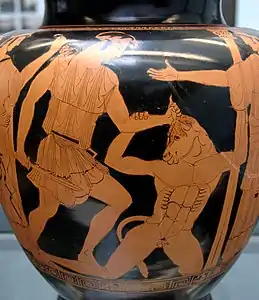 Theseus and the Minotaur. Side A from an Attic red-figure stamnos, c. 460 BC.
Theseus and the Minotaur. Side A from an Attic red-figure stamnos, c. 460 BC. Theseus and the Minotaur. Side A from a black-figure Attic amphora, c. 540 BC.
Theseus and the Minotaur. Side A from a black-figure Attic amphora, c. 540 BC.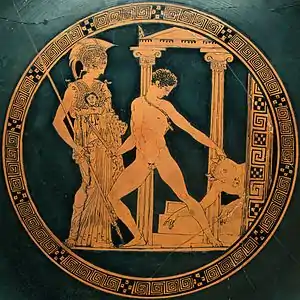 Tondo of the Aison Cup, showing the victory of Theseus over the Minotaur in the presence of Athena.
Tondo of the Aison Cup, showing the victory of Theseus over the Minotaur in the presence of Athena.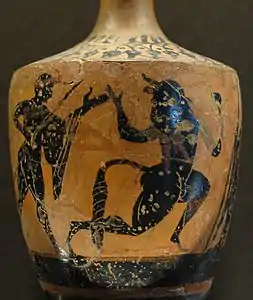 Theseus and the Minotaur. Attic black-figure lekythos, 500–475 BC. From Crimea.
Theseus and the Minotaur. Attic black-figure lekythos, 500–475 BC. From Crimea.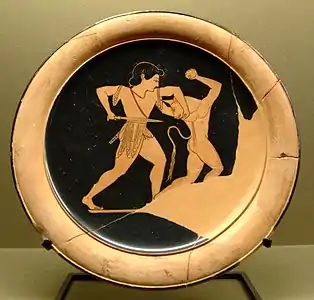 Theseus and the Minotaur. Attic red-figured plate, 520–510 BC.
Theseus and the Minotaur. Attic red-figured plate, 520–510 BC.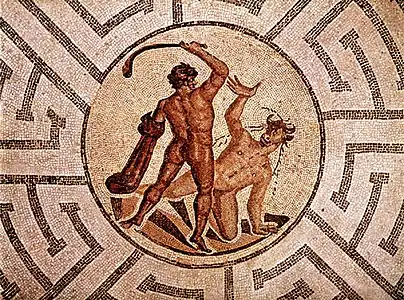 Theseus and the Minotaur
Theseus and the Minotaur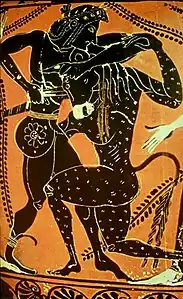 Theseus and the Minotaur
Theseus and the Minotaur Theseus and the Minotaur
Theseus and the Minotaur
References in media
Dante's Inferno

The Minotaur (infamia di Creti, Italian for 'infamy of Crete'), appears briefly in Dante's Inferno, in Canto 12 (l. 12–13, 16–21), where Dante and his guide Virgil find themselves picking their way among boulders dislodged on the slope and preparing to enter into the seventh circle of hell.[34] Dante and Virgil encounter the beast first among the "men of blood": those damned for their violent natures. Some commentators believe that Dante, in a reversal of classical tradition, bestowed the beast with a man's head upon a bull's body,[35] though this representation had already appeared in the Middle Ages.[4](pp 116–117)
Lo savio mio inver' lui gridò: "Forse |
My sage cried out to him: "You think, |
| —Inferno, Canto XII, lines 16–20 |
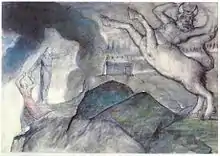
In these lines, Virgil taunts the Minotaur to distract him, and reminds the Minotaur that he was killed by Theseus the Duke of Athens with the help of the monster's half-sister Ariadne. The Minotaur is the first infernal guardian whom Virgil and Dante encounter within the walls of Dis.[lower-alpha 7] The Minotaur seems to represent the entire zone of Violence, much as Geryon represents Fraud in Canto XVI, and serves a similar role as gatekeeper for the entire seventh Circle.[37]
Giovanni Boccaccio writes of the Minotaur in his literary commentary of the Commedia: "When he had grown up and become a most ferocious animal, and of incredible strength, they tell that Minos had him shut up in a prison called the labyrinth, and that he had sent to him there all those whom he wanted to die a cruel death".[38] Dante Gabriel Rossetti, in his own commentary,[39][40] compares the Minotaur with all three sins of violence within the seventh circle: "The Minotaur, who is situated at the rim of the tripartite circle, fed, according to the poem was biting himself (violence against one's body) and was conceived in the 'false cow' (violence against nature, daughter of God)."
Virgil and Dante then pass quickly by to the centaurs (Nessus, Chiron and Pholus) who guard the Flegetonte ("river of blood"), to continue through the seventh Circle.[41]
Surrealist art

- Pablo Picasso made a series of etchings in the Vollard Suite showing the Minotaur being tormented, possibly inspired also by Spanish bullfighting.[42]
Television, literature and plays
- Argentine author Julio Cortázar published the play Los reyes (The Kings) in 1949, which reinterprets the Minotaur's story. In the book, Ariadne is not in love with Theseus, but with her brother the Minotaur.[43]
- The short story The House of Asterion by the Argentine writer Jorge Luis Borges gives the Minotaur's story from the monster's perspective.
- Asterion, depicted as a human prince who wears a bull mask, is the chief antagonist of The King Must Die, Mary Renault's 1958 reinterpretation of the Theseus myth in the light of the excavation of Knossos.
- Aleksey Ryabinin's book Theseus (2018).[44][45] provides a retelling of the myths of Theseus, Minotaur, Ariadne and other personages of Greek mythology.
- In the horror novel House of Leaves (2000) by author Mark Z. Danielewski the myth of the Minotaur is retold from the perspective of King Minos and functions as a recurring theme. Additionally the legend serves as a parallel to the labyrith-like architecture of The House on Ash Tree Lane, which is the main subject of the book.
Film
- Minotaur, the Wild Beast of Crete, a 1960 Italian film directed by Silvio Amadio and starring Bob Mathias[46]
- Minotaur, a horror adaptation of the legend starring Tom Hardy as Theo (Theseus), was released on DVD by Lions Gate in 2006.[47]
- Natalie Portman and Danny McBride fight a minotaur while reclaiming a magical sword from a labyrinth in Your Highness, released in 2011 by Universal Pictures.[48]
See also
- Theseus and the Minotaur - a logic game that is inspired by the myth of Theseus and the Minotaur in the Labyrinth.
- Kao (bull) – a legendary chaotic bull in Meitei mythology, similar to Minotaur in character
- Ox-Head and Horse-Face – two guardians or types of guardians of the underworld in Chinese mythology
- Satyr – a legendary human-horse (later human-goat) hybrid(s)
- Shedu – a figure in Mesopotamian mythology with the body of a bull and a human head
- Minotauria – a genus of woodlouse hunting spiders endemic to the Balkans[49]
Footnotes
- ↑
According to Ovid:
- semibovemque virum semivirumque bovem,[5] one of the three lines that his friends would have deleted from his work, and one of the three that he, selecting independently, would preserve at all cost, in the apocryphal anecdote told by Albinovanus Pedo.[6]
- ↑ In a counter-intuitive cultural development going back at least to Cretan coins of the 4th century BCE, many visual patterns representing the Labyrinth do not have dead ends like a maze; instead, a single path winds to the center.[8]
- ↑
Hesiod[10] says of Zeus' establishment of Europa in Crete:
- "... he made her live with Asterion the king of the Cretans. There she conceived and bore three sons, Minos, Sarpedon, and Rhadamanthys."[10]
- ↑ Sir Arthur Evans, the first of many archaeologists who have worked at Knossos, is often given credit for this idea, but he did not believe it;[25] modern scholarship generally discounts the idea.[4](pp 42–43)[7](p 25)
- ↑ Callimachus first refers to the minotaur with the phrase
- ↑ Kaplan argues that the minotaur is the result of ancient people trying to explain earthquakes;[32] he points out that carbon dating of marine fossils attached to boulders that were ejected from the ocean by ancient tsunamis indicates the region was tectonically very active during the years when the minotaur myth first appeared.[33] Given this, he argues that the Minoans used the monster to help explain the terrifying earthquakes that were "bellowing" beneath their feet.
- ↑ The fallen angels, the Erinyes [Furies], and the unseen Medusa were located on the City of Dis's defensive ramparts.[36]
References
- 1 2 "English Dictionary: Definition of Minotaur". Collins. Retrieved 20 July 2013.
- 1 2 Bechtel, John Hendricks (1908), Pronunciation: Designed for Use in Schools and Colleges and Adapted to the Wants of All Persons who Wish to Pronounce According to the Highest Standards, Penn Publishing Co.
- ↑ Garnett, Richard; Vallée, Léon; Brandl, Alois (1923), The Book of Literature: A Comprehensive Anthology of the Best Literature, Ancient, Mediæval and Modern, with Biographical and Explanatory Notes, vol. 33, Grolier society.
- 1 2 3 4 5 6 7 Kern, Hermann (2000). Through the Labyrinth. Munich, London, New York: Prestel. ISBN 379132144-7.
- ↑ Ovid. Ars Amatoria. 2.24.
- ↑ A. Pedo cited by Rusten, J.S. (Autumn 1982). "Ovid, Empedocles, and the Minotaur". The American Journal of Philology. 103 (3): 332–333, esp. 332. doi:10.2307/294479. JSTOR 294479.
- 1 2 Doob, Penelope Reed (April 1990). The Idea of the Labyrinth: From Classical antiquity through the Middle Ages. Ithaca, NY: Cornell University Press. ISBN 978-080142393-2.
- ↑ Kern (2000);[4](Chapter 1) Doob (1990)[7](Chapter 2)
- ↑ Pausanias. Description of Greece. 2.31.1.
- 1 2 Hesiod. Catalogue of Women. fr. 140.
- ↑ de Simone, C. (1970). "Zu einem Beitrag über etruskisch θevru mines". Zeitschrift für vergleichende Sprachforschung. 84: 221–223.
- ↑ "Minotaur". American English Dictionary. Collins. Retrieved 20 July 2013.
- ↑ "Apollodorus, Library, book 3, chapter 1". www.perseus.tufts.edu. Retrieved 18 May 2023.
- ↑ Chisholm, Hugh, ed. (1911). . Encyclopædia Britannica. Vol. 18 (11th ed.). Cambridge University Press. p. 555.
- ↑ Several examples are shown in Kern (2000).[4]
- ↑ Examples include illustrations 204, 237, 238, and 371 in Kern.[4]
- ↑ The Aeneid of Virgil, as translated by John Dryden, found at http://classics.mit.edu/Virgil/aeneid.6.vi.html . Virgil's text calls the Minotaur "biformis"; like Ovid, he does not describe which part is bull, which part man.
- ↑ "Pausanias, Description of Greece, Attica, chapter 27". www.perseus.tufts.edu. Retrieved 18 May 2023.
- ↑ Catullus. Carmen 64.
- ↑ Servius. On the Aeneid. 6.14.
singulis quibusque annis 'every one year'.
- The annual period is given by Zimmerman, J.E. (1964). "Androgeus". Dictionary of Classical Mythology. Harper & Row; and Rose, H.J. (1959). A Handbook of Greek Mythology. Dutton. p. 265. Zimmerman cites Virgil, Apollodorus, and Pausanias.
- ↑ "Isocrates, Helen, section 27". www.perseus.tufts.edu. Retrieved 18 May 2023.
- ↑ Plutarch. Theseus. 15–19.Diodorus Siculus. Bibliotheca historica. i.16, iv.61.Apollodorus. Bibliotheke. iii.1, 15.
- ↑ Apollodorus. Bibliotheca. 3.1.4.
- ↑ Hogan, C. Michael (2007). Cope, Julian (ed.). "Knossos fieldnotes". The Modern Antiquarian.
- ↑ McCullough, David (2004). The Unending Mystery. Pantheon. pp. 34–36.
- ↑ Chisholm, Hugh, ed. (1911). . Encyclopædia Britannica. Vol. 18 (11th ed.). Cambridge University Press. p. 555.
- ↑ Paolo Alessandro Maffei (1709), Gemmae Antiche, Pt. IV, pl. 31; Kern (2000): Maffei "erroneously deemed the piece to be from Classical antiquity".[4](p 202, fig. 371)
- ↑ Kerenyi, Karl (1951). The Gods of the Greeks. p. 269.
- ↑ See illustrations of Carme, for an example of a goddess crowned with a labyrinthine wreath of grain.
- ↑ Kerényi, Karl (1976). Dionysos: Archetypal Image of Indestructible Life. pp. 104–105, 159.
- 1 2 Callimachus (1921). Callimachus, Hymns and Epigrams. Translated by Mair, A.W.; Mair, G.R. Cambridge, MA: Harvard University Press.
- ↑ Kaplan, Matt (2012). Science of Monsters. New York, NY: Simon & Schuster.
- ↑ Scheffers, Anja; et al. (2008). "Late Holocene tsunami traces on the western and southern coastlines of the Peloponnesus (Greece)". Earth and Planetary Science Letters. 269 (1–2): 271–279. Bibcode:2008E&PSL.269..271S. doi:10.1016/j.epsl.2008.02.021.
- ↑ The traverse of this circle is a long one, filling Cantos 12 to 17.
- ↑ Inferno XII, verse translation by R. Hollander, p. 228 commentary
- ↑ Alighieri, Dante. "Canto IX". Inferno.
- ↑ Boccaccio, Comedia delle ninfe fiorentine commentary
- ↑ Boccaccio, G. (30 November 2009). Boccaccio's Expositions on Dante's Comedy. University of Toronto Press.
- ↑ Bennett, Pre-Raphaelite Circle, 177-180.
- ↑ "Dante Gabriel Rossetti. His Family-Letters with a Memoir (Volume Two)". www.rossettiarchive.org.
- ↑ Beck, Christopher, "Justice among the Centaurs", Forum Italcium 18 (1984): 217–229
- ↑ Tidworth, Simon, "Theseus in the Modern World", essay in The Quest for Theseus London 1970 pp. 244–249 ISBN 0269026576
- ↑ De Laurentiis, Antonella (2009). "Los reyes: El laberinto entre mito e historia" [Los reyes: The Labyrinth Between Myth and History]. Amaltea. Revista de mitocrítica (in Spanish). Universidad Complutense de Madrid. 1: 145–155. ISSN 1989-1709.
- ↑ A.Ryabinin. Theseus. The story of ancient gods, goddesses, kings and warriors. – СПб.: Антология, 2018. ISBN 978-5-6040037-6-3.
- ↑ O.Zdanov. Life and adventures of Theseus. // «KP», 14 February 2018.
- ↑ "The Minotaur, the Wild Beast of Crete". Letter Box. Retrieved 2 May 2019.
- ↑ Jonathan English (director). Minotaur (2005). Retrieved 2 March 2018 – via AllMovie.
- ↑ Your Highness. AllMovie. Retrieved 14 October 2022.
- ↑ Kulczyński, W. (1903). "Aranearum et Opilionum species in insula Creta a comite Dre Carolo Attems collectae". Bulletin International de l'Académie des Sciences de Cracovie. 1903: 32–58.
External links
- Minotaur in Greek Myth source Greek texts and art.